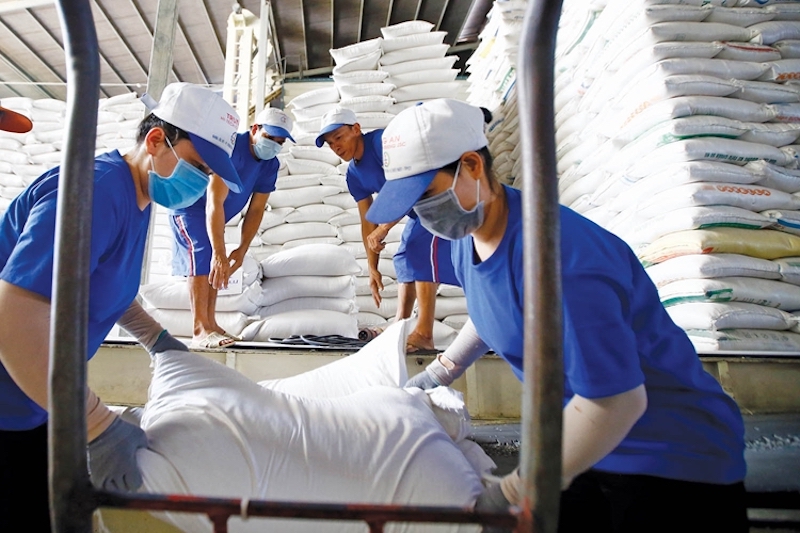Rice exporters seize unprecedented opportunity
Many other countries have turned to Vietnam and Thailand to seek rice imports amid unfavorable weather fluctuations caused by El Nino, which significantly impacted rice production in many nations.
According to data from the Ministry of Agriculture and Rural Development, in July 2023, the export turnover of agricultural products reached $2.32 billion, up 27%; livestock products reached $45 million, up 35.6%; fisheries reached $800 million, down 15%; forestry products reached $1.24 billion, down 11%; and input materials for production reached $210 million, up 12.7% compared to the same period last year.
Notably, Vietnam's rice exports during the first seven months of 2023 reached 4.84 million tons, valued at $2.58 billion, up 29.6% compared to the same period last year.

Deputy Minister of Agriculture and Rural Development, Phung Duc Tien, stated that with many countries restricting rice exports such as India, Russia, and the UAE, this is an opportunity for Vietnam to export rice with high value and quality. It is also an opportunity for rice farmers, especially those in the Mekong Delta, to increase their income.
"The Ministry of Agriculture and Rural Development has submitted a directive on enhancing rice exports in the current context to the Prime Minister. The directive will clarify the responsibilities of ministries, sectors, localities, and enterprises. After the directive is issued, these entities will focus on implementing it, removing difficulties for businesses and farmers to take advantage of rice export opportunities", said Mr. Tien.
Earlier, after India's announcement of banning rice exports, most countries turned to Vietnam and Thailand to find alternatives due to adverse weather conditions, particularly the El Nino phenomenon, which had a significant impact on rice production in many countries worldwide. Currently, China, the Philippines, and Indonesia are competing to buy Vietnamese rice.
Data from the General Statistics Office showed that in 1H23, Vietnam's rice exports reached over 4.2 million tons, valued at $2.26 billion, up over 21% in quantity and 32% in value compared to the same period last year, with an average export price of $539/ton, a 10.2% increase from the same period in 2022. With these results, Vietnam rice industry is expected to achieve over 8 million tons of rice exports throughout the year, an increase of 1 million tons compared to 2022.
The favorable conditions for accelerating rice exports also pose challenges to ensure the national food security. This year, the country is expected to produce between 43.2 and 43.4 million tons of rice, up 1.8-2% compared to 2022. With this rice production, domestic food security will be ensured, and exports are projected to reach 7-7.5 million tons.
Currently, localities are speeding up the planting of Summer-Autumn and Autumn-Winter crops, caring for and harvesting the Summer-Autumn crop. By mid-July 2023, Vietnam had planted nearly 6.2 million hectares of rice, down 0.8% compared to the same period last year. Localities had also harvested nearly 3.7 million hectares, down 0.8% compared to the same period last year. However, with an average yield of 65.7 tons per hectare, an increase of 0.8 tons per hectare, the rice harvest reached over 24.1 million tons, up 0.4%.
In July 2023, the prices of Summer-Autumn rice in the Mekong Delta increased due to active trading and good demand for rice. Specifically, the IR50404 rice price reached 6,500 VND/kg; OM 5451 rice reached 6,800 VND/kg, and fragrant rice reached 6,950 VND/kg.
Regarding India's ban on rice bran exports and its impact on Vietnam's livestock feed production, Mr. Pham Kim Dang, Deputy Director of the Livestock Department under the Ministry of Agriculture and Rural Development, stated that Vietnam's demand for rice bran is not significant, and rice bran is not a critical component in livestock feed production. Vietnam requires about 4.7 million tons of rice bran annually for livestock feed, but the domestic market supplies around 4 million tons of rice bran, with only 0.7 million tons imported, and rice bran accounts for only 5-10% of the ingredients.

Mr. Pham Kim Dang further noted that rice bran can be replaced with wheat bran, as wheat bran has high nutritional value and a reasonable price. The ban on rice bran exports by India is not a concern for Vietnam's livestock feed production.
Despite favorable conditions for rice exports, Vietnam has also faced the challenges of El Nino. According to Mr. Pham Kim Dang, El Nino will strongly affect rice production in the Mekong Delta starting around October, especially during the Winter-Spring crop in 2023-2024. Compared to other rice-growing countries in the world, Vietnam will be less affected by El Nino, but this should not be taken lightly.
In sum, Vietnam is seizing the opportunity of rising rice prices to boost rice exports, but it must also be prepared for challenges related to food security and weather conditions. Vietnam's rice production is expected to increase, but careful planning and strategic measures are needed to ensure food security and sustainable growth in the rice industry.








